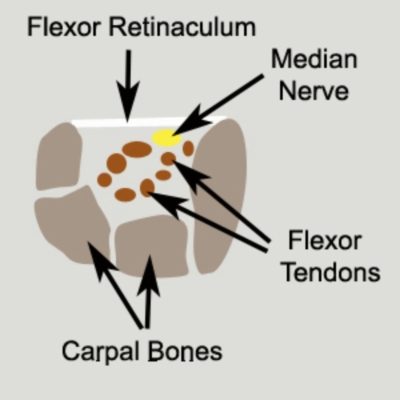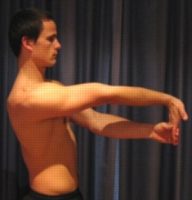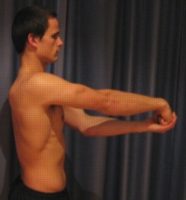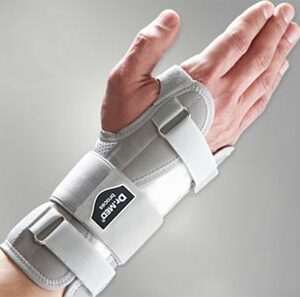Carpal Tunnel Syndrome
Updated:
What is carpal tunnel syndrome?
The wrist comprises of several small bones collectively known as the carpal bones. The carpal bones are interconnected via strong ligaments and connective tissue known as the flexor retinaculum. Collectively, this arrangement forms a space known as the carpal tunnel (figure 1).

The carpal tunnel contains numerous flexor tendons from the muscles of the forearm allowing them to attach to the wrist and fingers via the carpal tunnel. In addition, a nerve known as the median nerve lies within the carpal tunnel (figure 1). The median nerve is responsible for supplying some sensation and motor control to the hand.
Occasionally, the carpal tunnel may narrow resulting in compression of the median nerve. When this occurs, the condition is known as carpal tunnel syndrome.
Carpal tunnel syndrome normally occurs following damage to the flexor tendons within the carpal tunnel. This results in swelling and inflammation of the tendons, thereby reducing the dimensions of the carpal tunnel, compressing the median nerve.
Damage to the flexor tendons usually occurs due to overuse of the forearm flexors. During contraction of the forearm flexors, tension is placed through the flexor tendons within the carpal tunnel. When this tension is excessive due to too much repetition or high force, damage to the tendons may occur. This is usually due to gradual wear and tear associated with overuse, however, it may also occur traumatically due to a specific incident.
Although carpal tunnel syndrome can occur at any age, it is commonly seen in patients greater than 50. Carpal tunnel syndrome is also more common in women and usually affects the dominant hand. Occasionally, it may affect both hands.
Causes of carpal tunnel syndrome
Carpal tunnel syndrome typically occurs in association with activities that place repetitive stress through the flexor tendons. These activities may include sports such as gymnastics, cycling, golf or racquet sports as well as manual work such as carpentry, painting, chopping wood, bricklaying, repetitive use of a screwdriver, use of vibrating machinery, sewing and knitting or working at a computer. Carpal tunnel syndrome may also occur from other activities involving forceful or repetitive gripping of the hand.
It is common for patients to develop this condition following a sudden increase in activities that place stress on the flexor tendons or due to a change in these activities. Occasionally, carpal tunnel syndrome may develop suddenly. This can be due to a fall onto an outstretched hand causing a sprain or fracture of the wrist, or due to a forceful movement involving heavy lifting or a gripping force through the wrist.
A history of wrist, elbow, shoulder, neck or upper back injury may increase the likelihood of a patient developing this condition. In addition, patients who are pregnant, suffer from arthritis or diabetes and those who are born with a narrow carpal tunnel may also be more likely to develop carpal tunnel syndrome.
Signs and symptoms of carpal tunnel syndrome
The symptoms associated with this condition usually develop gradually over a period of time. Initially, symptoms may present as an ache in the wrist and hand following an aggravating or unaccustomed activity. This may often be felt at night or first thing in the morning. As the condition progresses, pain or a burning sensation may be felt with every day activities involving the wrist and fingers such as carrying groceries, opening a jar, shaking hands or using the computer. Pins and needles or numbness in the fingers (excluding the little finger) may be detected along with weakness in the fingers and thumb. This may present as difficulty performing fine movements of the hand, reduced grip strength, or an increased frequency of dropping objects. Patients with this condition will often experience wrist and finger stiffness upon waking in the morning.
Occasionally, carpal tunnel syndrome may be associated with neck or upper back pain on the same side. In severe cases, obvious wasting of the muscles of the thumb and hand may be detected.
Diagnosis of carpal tunnel syndrome
A thorough subjective and objective examination from a physiotherapist may be sufficient to diagnose carpal tunnel syndrome. Nerve conduction studies are often required to confirm diagnosis.
Treatment for carpal tunnel syndrome
Most cases of carpal tunnel syndrome settle well with appropriate physiotherapy. This includes careful assessment by the physiotherapist to determine which factors have contributed to the development of the condition, with subsequent correction of these factors.
The success rate of treatment for patients with this condition is largely dictated by patient compliance. One of the key components of treatment is that the patient rests sufficiently from ANY activity that increases their pain until they are symptom free. Activities which place large amounts of stress through the forearm flexors should be minimized, these include: racquet sports, gripping activities, opening jars, cans or doors, carrying or lifting. Resting from aggravating activities ensures that the body can begin the healing process in the absence of further tissue damage. Once the patient can perform these activities pain free, a gradual return to these activities is indicated provided there is no increase in symptoms.
Ignoring symptoms or adopting a ‘no pain, no gain’ attitude is likely to lead to the problem becoming chronic. Immediate, appropriate treatment in patients with this condition is essential to ensure a speedy recovery. Once the condition is chronic, healing slows significantly resulting in markedly increased recovery times.
Patients with carpal tunnel syndrome will usually benefit from following the R.I.C.E. Regime. The R.I.C.E regime is beneficial in the initial phase of the injury (first 72 hours) or when inflammatory signs are present (i.e. morning pain or pain with rest). This involves resting from aggravating activities (often with the use of a splint or Wrist Brace), regular icing, the use of a compression bandage and keeping the arm elevated. Anti-inflammatory medication may also significantly hasten the healing process by reducing the pain and swelling associated with inflammation.
Patients with carpal tunnel syndrome should perform pain-free flexibility and strengthening exercises as part of their rehabilitation to ensure an optimal outcome. The treating physiotherapist can advise which exercises are most appropriate for the patient and when they should be commenced.
Prognosis of carpal tunnel syndrome
With appropriate management and physiotherapy, most minor cases of carpal tunnel syndrome that have not been present for long can usually recover within a few weeks. In more severe and chronic cases recovery can be a lengthy process and may take more than 6 months in those who have had their condition for a long period of time. Early physiotherapy intervention is therefore vital to hasten recovery.
Contributing factors to the development of carpal tunnel syndrome
There are several factors which can predispose patients to developing this condition. These need to be assessed and corrected with direction from a physiotherapist. Some of these factors include:
- excessive training or activity
- muscle weakness
- muscle tightness
- joint tightness
- poor sporting technique or equipment
- inadequate warm-up
- Injury to the neck, upper back and nerves
Physiotherapy for carpal tunnel syndrome
Physiotherapy treatment for carpal tunnel syndrome is vital to hasten the healing process, ensure an optimal outcome and decrease the likelihood of future recurrence. Treatment may comprise:
- soft tissue massage
- electrotherapy
- bracing or splinting
- joint mobilization
- dry needling
- ice or heat treatment
- progressive exercises to improve flexibility and strength
- education
- training and activity modification advice
- technique correction
- anti-inflammatory advice
- devising an appropriate return to activity plan
Other intervention for carpal tunnel syndrome
Despite appropriate physiotherapy management, some patients with carpal tunnel syndrome do not improve. When this occurs the treating physiotherapist or doctor can advise on the best course of management. This may include nerve conduction studies, X-rays, ultrasound or MRI investigations, pharmaceutical intervention, corticosteroid injection, or referral to appropriate medical authorities who can advise on any intervention that may be appropriate to improve the condition.
Surgery for carpal tunnel syndrome
Occasionally, surgical intervention may be required to decompress the median nerve in patients with carpal tunnel syndrome. This operation is relatively common and involves cutting the connective tissue that forms the roof of the carpal tunnel to allow more space for the median nerve. Following surgery, the wrist may be bandaged and placed in a sling or splint for 1 – 2 weeks. Rehabilitation with physiotherapy is required following the procedure to ensure an optimal outcome.
Exercises for carpal tunnel syndrome
The following exercises are commonly prescribed to patients with this condition. You should discuss the suitability of these exercises with your physiotherapist prior to beginning them. Generally, they should be performed 3 times daily and only provided they do not cause or increase symptoms.
Wrist Flexor Stretch
Keeping your elbow straight, take your wrist and fingers backwards using your other hand until you feel a mild to moderate stretch pain-free (figure 2) . Hold for 15 seconds and repeat 4 times provided there is no increase in symptoms.

Figure 2 – Wrist Flexor Stretch (right side)
Wrist & Finger Extensor Stretch
Keeping your elbow straight, curl your wrist and fingers up using your other hand until you feel a mild to moderate stretch pain-free (figure 3) . Hold for 15 seconds and repeat 4 times provided there is no increase in symptoms.

Physiotherapy products for carpal tunnel syndrome
Some of the most commonly recommended products by physiotherapists to hasten healing and speed recovery in patients with this condition include:
To purchase physiotherapy products for carpal tunnel syndrome, click on one of the above links or visit the PhysioAdvisor Shop.
Other wrist exercises
- View more Wrist Flexibility Exercises.
- View Wrist Strengthening Exercises.
Find a Physio for carpal tunnel syndrome
Find a Physiotherapist in your local area who can treat this condition.

Link to this Page
If you would like to link to this article on your website, simply copy the code below and add it to your page:
<a href="https://physioadvisor.com.au/injuries/wrist-hand/carpal-tunnel-syndrome”>Carpal Tunnel Syndrome – PhysioAdvisor.com</a><br/>PhysioAdvisor offers detailed physiotherapy information on carpal tunnel syndrome including: causes, symptoms, diagnosis, treatment, exercises, physiotherapy products and more...
Return to the top of Carpal Tunnel Syndrome.


